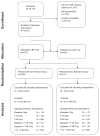Orthostatic Hypotension in the ACCORD (Action to Control Cardiovascular Risk in Diabetes) Blood Pressure Trial: Prevalence, Incidence, and Prognostic Significance
- PMID: 27504006
- PMCID: PMC5016241
- DOI: 10.1161/HYPERTENSIONAHA.116.07474
Orthostatic Hypotension in the ACCORD (Action to Control Cardiovascular Risk in Diabetes) Blood Pressure Trial: Prevalence, Incidence, and Prognostic Significance
Abstract
Orthostatic hypotension (OH) is associated with hypertension and diabetes mellitus. However, in populations with both hypertension and diabetes mellitus, its prevalence, the effect of intensive versus standard systolic blood pressure (BP) targets on incident OH, and its prognostic significance are unclear. In 4266 participants in the ACCORD (Action to Control Cardiovascular Risk in Diabetes) BP trial, seated BP was measured 3×, followed by readings every minute for 3 minutes after standing. Orthostatic BP change, calculated as the minimum standing minus the mean seated systolic BP and diastolic BP, was assessed at baseline, 12 months, and 48 months. The relationship between OH and clinical outcomes (total and cardiovascular death, nonfatal myocardial infarction, nonfatal stroke, heart failure hospitalization or death and the primary composite outcome of nonfatal myocardial infarction, nonfatal stroke, and cardiovascular death) was assessed using proportional hazards analysis. Consensus OH, defined by orthostatic decline in systolic BP ≥20 mm Hg or diastolic BP ≥10 mm Hg, occurred at ≥1 time point in 20% of participants. Neither age nor systolic BP treatment target (intensive, <120 mm Hg versus standard, <140 mm Hg) was related to OH incidence. Over a median follow-up of 46.9 months, OH was associated with increased risk of total death (hazard ratio, 1.61; 95% confidence interval, 1.11-2.36) and heart failure death/hospitalization (hazard ratio, 1.85, 95% confidence interval, 1.17-2.93), but not with the primary outcome or other prespecified outcomes. In patients with type 2 diabetes mellitus and hypertension, OH was common, not associated with intensive versus standard BP treatment goals, and predicted increased mortality and heart failure events.
Keywords: cardiovascular diseases; clinical trials; diabetes mellitus; hypertension; hypotension; orthostatic; randomized; type 2.
© 2016 American Heart Association, Inc.
Figures


Comment in
-
Orthostatic Hypotension in Diabetics in the ACCORD (Action to Control Cardiovascular Risk in Diabetes) Blood Pressure Trial.Hypertension. 2016 Oct;68(4):851-2. doi: 10.1161/HYPERTENSIONAHA.116.07605. Epub 2016 Aug 8. Hypertension. 2016. PMID: 27504005 No abstract available.
References
-
- Consensus Statement. The definition of orthostatic hypotension, pure autonomic failure and multiple system atrophy. Clin Autonomic Res. 1996;6:125–126. - PubMed
-
- Matthias CJ. Orthostatic hypotension: causes, mechanisms and influencing factors. Neurology. 1995;45(suppl 5):S6–S11. - PubMed
-
- Wu JS, Lu FH, Yang YC, Chang CJ. Postural hypotension and postural dizziness in patients with non-insulin dependent diabetes. Arch Int Med. 1999;159:1350–1356. - PubMed
-
- Mader SL. Orthostatic hypotension. Med Clin North Am. 1989;73:1337–1349. - PubMed
-
- Eigenbrodt ML, Rose KM, Cooper DJ, Arnett DK, Smith R, Jones D. Orthostatic hypotension as a risk factor for stroke. The Atherosclerosis Risk in Communities (ARIC ) Study 1987–1996. Stroke. 2000;3:2307–2313. - PubMed
Publication types
MeSH terms
Substances
Grants and funding
LinkOut - more resources
Full Text Sources
Other Literature Sources
Medical

